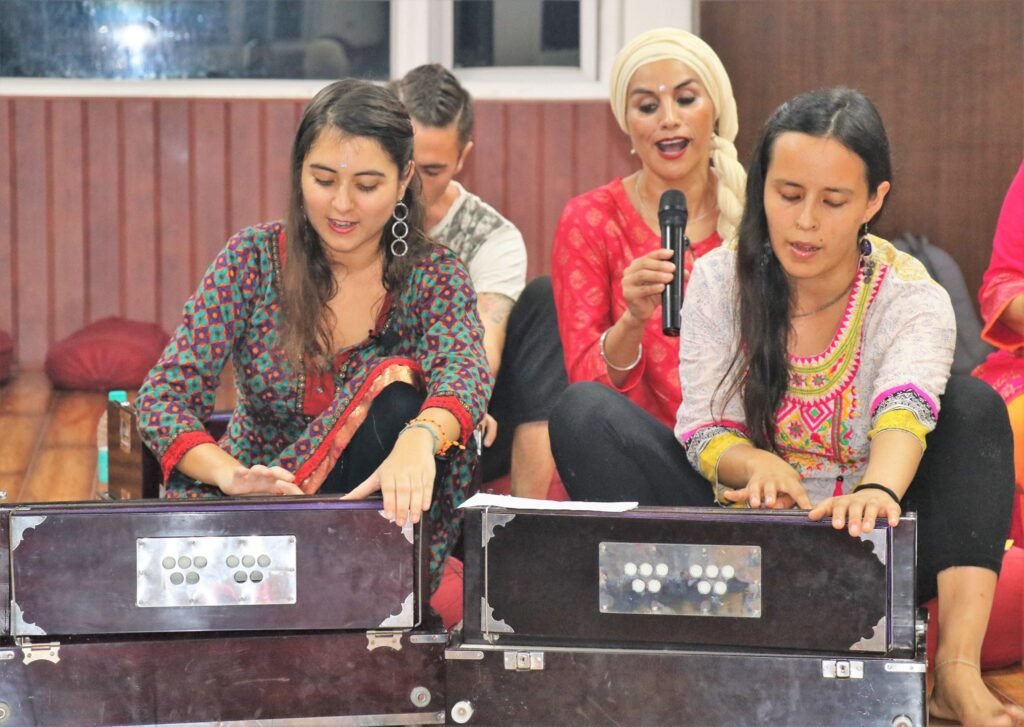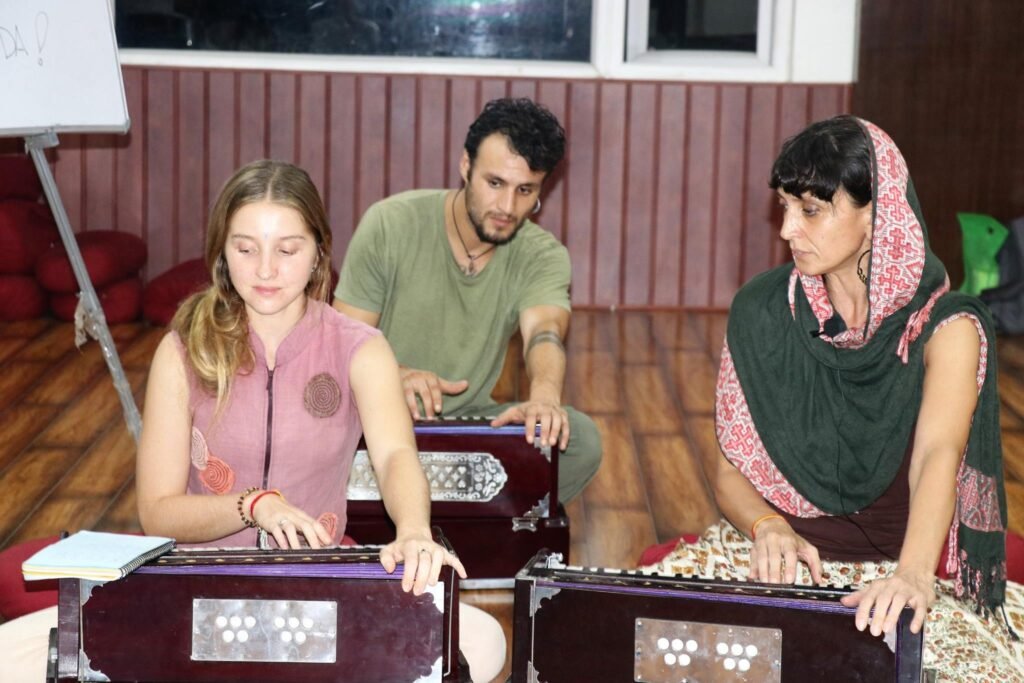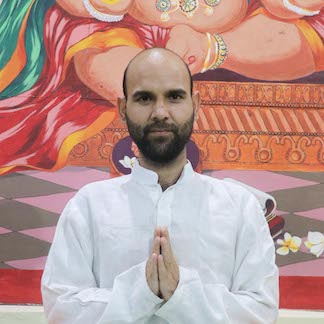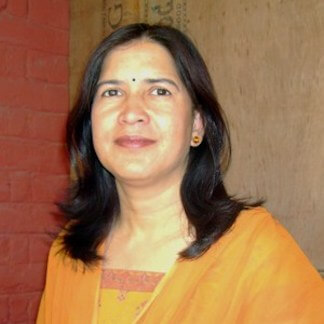Nada Yoga Teacher Training in Rishikesh, India

Nada Yoga Teacher Training is a specialized program that focuses on the practice and teachings of Nada Yoga. Nada Yoga is the practice of yoga through sound and music. Nada Yoga is the yoga of sound or the yoga of vibration, which explores the use of sound and music as a means of self-realization and spiritual development. Nada Yoga Teacher Training programs are designed to provide a comprehensive understanding of this ancient practice and equip individuals with the skills and knowledge to teach Nada Yoga to others.
During a Nada Yoga Teacher Training program, participants learn about the philosophical and theoretical aspects of Nada Yoga, as well as the practical techniques and methods for incorporating sound and music into their personal practice and teaching.
We are delighted to offer the most comprehensive and unique Nada Yoga teacher training course in Rishikesh, India.
If you ever wanted to learn about this sacred practice, then this is your chance.
This course is suitable for yoga teachers, students (beginner, intermediate & advanced), and music lovers who want to connect/integrate the enlightening power of sacred sound (nada yoga) with their daily practice of yoga, meditation, or healing.
Nada Yoga Course
What is Nada Yoga?

Nada Yoga is a spiritual practice and a form of yoga that focuses on the use of sound and music as a means of attaining self-realization and spiritual enlightenment. “Nada” means “sound” or “vibration” in Sanskrit.
In Nada Yoga, practitioners explore the power of sound vibrations to harmonize and purify the mind, body, and spirit. It is based on the belief that everything in the universe, including our own bodies, is made up of vibrations. By attuning oneself to the subtle vibrations of sound, one can achieve a deep state of meditation and union with the divine.
The practice of Nada Yoga involves various techniques, including chanting, singing, listening to music, and focusing on internal sounds (such as the sound of one’s own breath or the heartbeat). These techniques are used to cultivate awareness, concentration, and a heightened sense of inner sound.
Nada Yoga is closely related to the concept of “Anahata Nada,” which refers to the inner sound or “unstruck sound” that is said to resonate within the heart chakra. Practitioners aim to perceive and merge with this inner sound through their practice.
The benefits of Nada Yoga include increased mindfulness, relaxation, and a deeper connection to one’s inner self. It is believed to enhance mental clarity, balance emotions, and promote overall well-being.
In short, attaining samadhi through sound is Nada Yoga. Nada Yoga is “union through sound”. The union of body, mind, and spirit.
Nada Yoga is a branch of Yoga in which transformation is brought through the Shabd or Nada. The nearest translation of Shabd and Nada is sound or vibration. But Shabd or Nada is not the same as sound because they can be produced either by striking two objects known as the Ahata sound or without striking two objects which are called the Anahata sound. Anahata sound can be heard at the Anahata or heart chakra.
Nada has the same place in Yoga as energy has in science. We can’t see energy, but we can feel it as vibrations. All energy and all vibrations generate sound.
Sound is one way for us to experience this energy.
Overview – Yoga Teacher Training in Rishikesh
- In this Yoga TTC, you will be immersed in the deep knowledge of Nada Yoga, its path (branches), and its philosophy.
- The course will be taught by talented and notable yogis and remarkable Yoga masters who have abundant experience in Yoga and its many branches.
- The course fee is all-inclusive.
- 3 to 5 hours of Nda Yoga practice.
- You will be given daily homework assignments.
- A final written exam is taken at the end of the course.
- After the completion of the yoga course, you will be certified with an internationally recognized Yoga Alliance Certificate.
- Indian Classical Music Concert, kirtans, and Bhajans Every week.
- You will be taken for local sightseeing on Sundays.
- Our School is situated in Rishikesh (also known as the world capital of Yoga), next to the Ganges river.
Together, we will explore:
Nada Yoga
In this Nada Yoga course, we will learn about nada yoga (the sacred sound) and its origin. Types of Nada Yoga. Is nada yoga practical or just philosophy. How does it affect your body and mind? What is the connection between Nada Yoga and Indian Music? Mantras and Nada Yoga. How to use nada yoga for healing. And much more as you will see below.
Sanskrit and Mantra Chanting
Mantra yokes the mind’s capacities to utilize it as a vehicle leading to higher intelligence. Mantras are said to have originated in the cosmic realm.
Lore has it that the play of Shiva’s damru is the source of all sound: called Nada – the divine vibration. From this stream, springs the Sanskrit alphabet. Each is a beej mantra that gives rise to further consonants.
This course is designed to help you understand the Sanskrit alphabet (with Devanagari script), its phonetical significance for varied applications, and each letter’s beej mantra and their origins with different intonations and pitch are well elaborated and explained.
You will learn the syllables of each mantra and consonants with accuracy.
You will also learn how to chant each mantra in the correct pitch, continuity, and flow to the desired effect.
The use of mantra is imperative for those who wish to deepen knowledge and experience of the spirituality of measured sound.
Mantras can be used as remedies for all types of life situations, rituals, and especially to deepen meditation. These mantras are also specifically used for healing therapies.
Nada Yoga and mantra sadhana teach the sequence to deepen these practices of meditation through mantra to obtain desired results.
Kirtans and Bhajans
Kirtan is call and response devotional singing to the glory of the divine in various forms. Kirtan can take the form of repeating the name or the stories of the manifestations.
Kirtan is done through the heart, feelings and emotions where devotion reigns supreme. It’s the straight and simple path in which no instructions or Guru is needed.
Bhajan means “to chant or repeat.” Bhajan is any kind of devotional song that may come in a variety of forms ranging from classical raag to folk music. Bhajans are usually sung solo.
Bhajans and kirtans forge emotional bond between the performer and the audience, making the art of performance a therapeutic and restorative experience.
Raagas and indian Music
At its core, Indian music is spiritual, and nearly all of it can be used in Nada Yoga.
Indian music originated in the chanting and singing of the Vedic mantras, particularly those from the Samveda. Later on, the evolution and growth of Indian music occurred in temples where it was used for prayer, worship and meditation.
Indian classical music produces slow brain waves which help in the reduction of thought and encourage a state of deep tranquility, and clearly that was the reason for its use in spiritual practice.
The primary aim of spiritual practice is to slow down the thought process, prevent the turbulent fluctuations of emotions and either bring the body to stillness or dance.
The basic structure of Indian classical music is Raga. Raga means “to color the mind and the spirit”, leading both to a state of higher consciousness. Each raga is a unique combination of notes which works as formula or a sutra, carrying specific mood and energy, which then connects to nature in general, and to a specific state of consciousness.
With practice, a musician experiences the essential core of the raga, contemplating and meditating upon it to unfold its essence and depth. This unfolding depends on each musician as ultimately the personality of the musician and the core of the raga merge, resulting in spiritual experience.
In this way, the act of playing a raga is an act of prayer, worship and meditation, transporting the individual to higher consciousness in a vertical movement.
Nada Yoga as Music & Sound Therapy
Nada Yoga can be used as music therapy/sound healing, for the physical, psychological and spiritual healing and well-being of a person or group.
It’s more effective than the current music and sound therapy because in addition to the music component, it involves yoga
poses, breathing techniques, meditations and detoxification methods. In other words, it’s a holistic healing practice which includes body, emotions and cognitive ability, and can be used as a preventive or curative measure.
In terms of prevention, Nada Yoga is useful to relieve stress and create harmony between body and mind for the better balance or
homeostasis of both. Nada Yoga can help in dealing with many chronic health problems including dementia and Parkinsonism.
Nada Yoga can be active or receptive. Actively, in Nada Yoga a person creates vocal or instrumental music to express and heal. In receptive mode, the individual listens to sounds and music. Visualization, touch, body movement and smell can be added to sound and music to enhance their effect on the brain and the body.
Introduction to Ayurveda
Ayurveda is an ancient vedic science that is closely related to the practice of yoga. Understanding of ayurvedic concepts will help you deepen the healing and compose diet and lifestyle that will suit our individual requirements.
The lectures of Ayurveda will include the study of –
- Basics of Ayurveda (elements, dhatus, doshas, and tastes)
- Kapha, Vatta, and Pitta. Knowing your body type.
- Daily routine, seasonal routine, diet regime, etc.
And much More...
Nada Yoga Teacher Training
Overview: Here's what you will learn
What is Nada Yoga?
Origin of Nada Yoga
Types of Nada Yoga
Nada Yoga Meditation
Learn Indian Raagas
Healing Through Indian Raagas
Reading of Roman transliteration of Devanagari
how to read and chant verses and mantras
Vedic chanting and their rules
Sanskrit alphabets, their sounds, and locations
Accurate Sanskrit pronunciation
What is mantra
Types of mantras
Origin of Mantras
Uses of mantra
How to chant mantra (sagun, nirgun, vedic, lokik, tantrik & beej mantra)
How to use the mantras for meditation and its sequence
How to play and lead Kirtans and Bhajans chants
How to play kirtans and bhajans on harmonium or sitar
How to use singing bowls for your teaching and practice
Music therapy and sound healing
How to match your body’s frequency to instruments sound
Effect of sound or nada in your daily life
Learn how to use everything you learn for teaching others and self practice
and much much more...
Certification
On successful completion of the course, you will be certified as a Nada Yoga Teacher. After which you can start guiding and healing others through the power of the sacred sound.
Graduates can also register with the International Yoga Registry, Yoga Alliance, USA under the 200-hour standard.
Nada Yoga TTC: Daily Schedule
Here’s a daily sample schedule for the nada yoga course –
06:00 am – 07:00 am: Pranayama/ Shatkarma/Sound Meditation
07:00 am – 08:30 am: Yoga Asanas
08:30 am – 09:30 am: Breakfast
10:00 am – 11:30 am: Music lessons/Mantras/Anatomy
12:00 pm – 01:00 pm: Lunch
01:00 pm – 02:00 pm: Nada Yoga
02:00 pm – 03:30 pm: Nada Yoga Philosophy
04:00 pm – 05:30 pm: Self Practice (Music, Mantra, Q/A, etc.)
06:00 pm – 07:00 pm: Meditation/Live Music Meditation/Mantra Chanting/Kirtan
07:30 pm – 08:00 pm: Dinner
Note: The schedule is subject to change.

Our Team of Professional Yoga Teachers
Nada Yoga School is comprised of a dynamic, experienced team of professional yoga teachers, who have in-depth knowledge encompassing diverse fields of yoga, offering students an initiation (exploration) into full yogic knowledge.

Nad Yogacharya Bhuwan Chandra

Yogi Mohan Panwar

Dr. Usha Vaishnava
and other guest teachers.
Food and Accommodation
- In our attempt to promote a yogic lifestyle, vegetarian meals, and herbal teas are served 3 times daily (breakfast/lunch/dinner) and prepared in our own equipped Kitchen, using filtered water. Please inform us of any dietary restrictions.
- Filtered water is available at all times during your stay at Nada Yoga School.
- Two students are accommodated in a shared, furnished double room with attached bath (cold/hot water) and ceiling fans. Bed linen, a towel, and a door lock are provided, however, residents are responsible for those items as well as laundering their sheets and cleaning their room.
- Single occupancy arrangements may be made prior to arrival, conditional to room availability, and may be subject to extra charges.
- Students are requested to arrive at the Nada Yoga School on the day prior to the commencement of the training, at which time they will be assigned to their rooms, and will be requested to finalize their course fee payments. Check-out is scheduled on the last day of the program. We request that all borrowed items be returned at this time.
Note: To create a positive atmosphere conducive to learning and continued personal development, drugs, alcohol and all other intoxicating substances are strictly prohibited for the entire duration of the course.
Nada Yoga Teacher Training Course: Upcoming Date
Dates
01 August - 28 August 2024
08 November - 05 December 2024
01 January - 28 January 2025
Location
Nada Yoga School, Rishikesh, India
Early Bird Fee
2000 USD
1497$
Hurry! Only 5 Spots Left!
(After that the price will increase to $2000)
(You only need to pay a deposit of $197 to reserve your spot. The remaining fee can be paid upon your arrival at Nada Yoga School)
Fee Includes:
- Access to a private nada yoga community to support lifetime learning
- Textbooks and printed course materials
- Welcome Kit (Jute Bag, T-Shirt, Notebook, Pen, Neti Pot, etc.)
- Lessons from 8 professional staff yoga teachers and guest lecturers.
- Music Concerts by renowned musicians of Rishikesh, India
- Use of props during the course (yoga mats, musical instruments, props, etc.)
- Vegetarian meals (3 times a day)
- Comfortable accommodation in the first established ashram in Rishikesh – Swargashram
- Local sightseeing (Sunrise at Kunjapuri Temple, Ganga Arti, etc.)
- Ganges river rafting
- Sunday movie night
- Wireless Internet Connectivity
